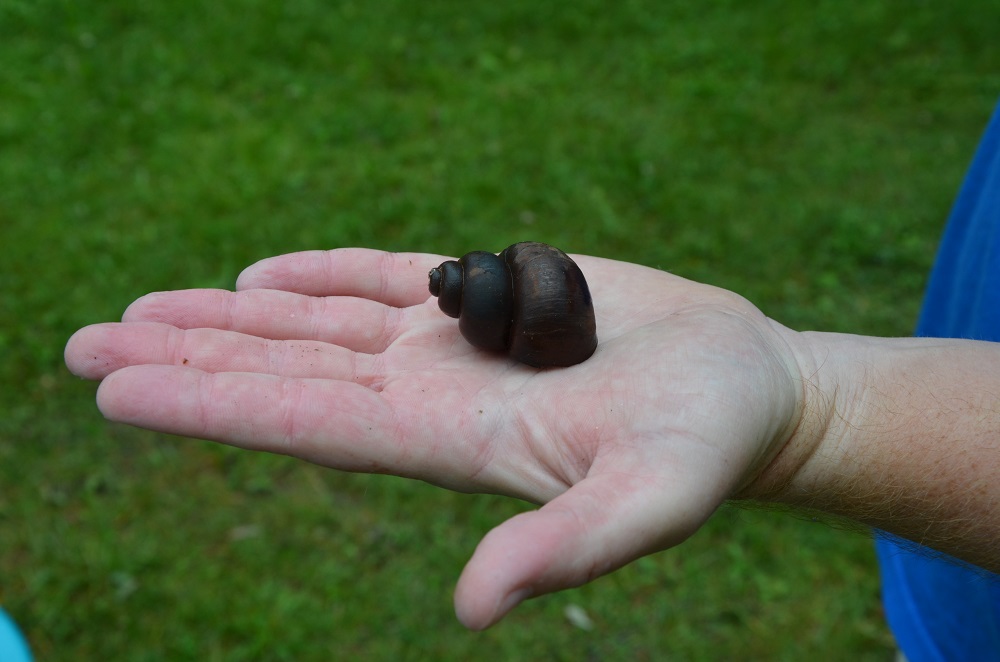The Coalition of Haliburton Property Owners Association (CHA), has again joined with the Ontario Federation of Anglers and Hunters (OFAH) Invasive Species Awareness Program.
Together they have more than 200 volunteers trained and licensed again this year to monitor and remove two invasive breeds of snails from many of the lakes in the area, the Chinese mystery snail and the Banded mystery snail.
“It is a fantastic program,” said Paul MacInnes, chair of the CHA, “The volunteers go through a training program to be licensed.” He said they try and have the licenses issued prior to the May long weekend so they can get on the lakes as early as possible.
The assistant co-ordinator at the OFAH, Brook Schryer, explained that without a license, it is illegal to remove the snails from the lakes. “In 2020, the CHA came to us about the mystery snails that were clogging up the shoreline making it difficult to recreate and enjoy their properties.” In 2021, the OFAH officially began the Mystery Snail Management and Removal program, which allowed them to apply to the Ministry of Natural Resources and Forestry (MNR) for a group license to collect fish for scientific purposes. “The training takes about two to three hours, and this year the majority of the volunteers were actually already trained from previous years,” Schryer said.
Training includes how to identify the invasive species, collect them, euthanize them, and dispose of them safely and properly. “It is nearly impossible to eradicate an established population of invasive species, especially aquatic,’ said Schryer. “So, the goal of this program from the outset was to provide volunteers with the agency to clean up their shorelines, protect their property values and just enjoy their waterfronts.”
Volunteers that took part in the program last year spent over 750 hours monitoring 30km of shoreline, in total there were 24 lakes that reported removal of the snails. “There is no cost to the volunteers, and the CHA carries an insurance rider, so they are all covered under our policy,” said MacInnes.
Tasks that come with being a volunteer with this program is reporting to the OFAH: how many snails were collected, what lake they were collected from and the area on that lake they were found. According to Schryer, about 685,000 mystery snails have been collected over the past two to three years. “The first year was very high, in the 550,000 range, the second year was about 135,000. We are uncertain as to what it’s going to look like this year, but we have received some initial reports and it sounds like there are some pretty dense populations.”
MacInnes echoed Schryer’s initial statement of the situation this year. “They have spread up through the majority of lakes now. I spoke to a woman just a few weeks ago who said that she and another licensee collected 8,000 snails on a Saturday afternoon in their lake.”
Not only do invasive species have a variety of societal impacts, like not being able to enjoy your property, but they also have a significant economic impact. Schryer stated that the annual cost in Ontario is in the millions, in Canada the estimated cost is around $35 billion, and “globally somewhere around $1.4 trillion.” He said it is known as the “invisible tax” because the average person doesn’t necessarily see it, but the dollars are being spent at all levels of government to deliver a variety of programs to try to manage invasive species and educate the pubic about invasive species.
The OFAH has an invading species hotline, 1-800-563-7711. Anybody in Ontario can call to ask questions. They also have an early detection and distribution mapping system at EDDMapS.org where people can actually go online to report invasive species in the province.





